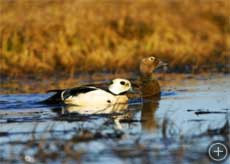Arctic Birds
The Arctic summer is a short but uproarious burst of life. For just a few months, the harsh climate of the Arctic relents. Snow thaws. The sun shines day and night. And in come the birds.
Well over a hundred different species of migratory birds fly to the Arctic to feed and breed each summer, taking advantage of the short-lived abundance of food and daylight. Among the birds of summer are albatross, bald eagles, peregrine falcons, tufted puffins, sandpipers, and eiders. The arctic tern makes the longest commute of them all, flying round-trip from the Arctic to the Antarctic—practically pole to pole—each year.
A few hardy species manage to live in the Arctic year-round. Snowy owls live on the tundra and hunt during the day, unlike their cousins, the great horned owls. To achieve seasonal camouflage, snowy owls actually change color. In the summer their plumage is brown with dark spots, to match the tundra. In the winter, they turn completely white. Chicken-like ptarmigans are also full-time residents of the Arctic; like the snowy owls, they change from brown to white each year.
Researchers in the Arctic are studying two endangered species of eider—steller’s and spectacled—for clues as to why their population has been dropping severely since the early 1990s. Lead poisoning from gunshot may be partly to blame, spurring a crusade to encourage hunters to switch from lead to steel shot. Eiders are famous for their down, which is a popular material in blankets. The female pulls this down from under her own breast feathers to line the nest and thereby insulate her incubating eggs, then leaves it behind when hatching is through.
To track the migrations of many of the birds that come to the Arctic, researchers attach radio transmitters to larger birds and “band” smaller ones (attach a colored band around a leg). Believe it or not, using a technique called stable isotope analysis, a wing feather plucked from a bird during the Arctic summer can be chemically analyzed to determine where that bird spent the previous winter.















